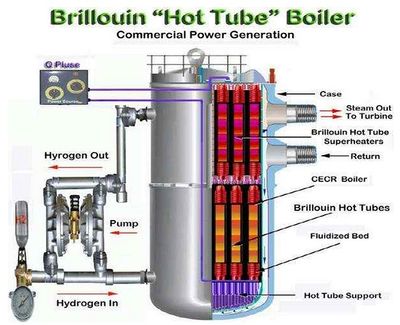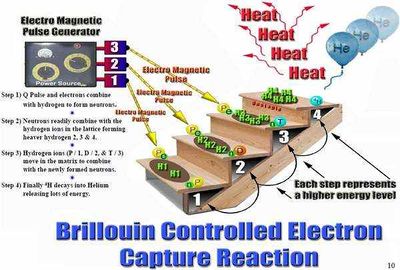Brillouin Energy: Unterschied zwischen den Versionen
K (→Brillouin Boiler: sprachl. gestrafft) |
|||
| Zeile 7: | Zeile 7: | ||
Ein Produkt der Brillouin Energy ist der Brillouin Boiler, der heißes Wasser mit Temperaturen zwischen 100 und 150 Grad C zur Verfügung stellen soll. Eine einmalige Befüllung des Reaktors reiche für einen 3 bis 5 Jahre dauernden Betrieb ohne weitere Befüllungen oder Veränderungen am Reaktor. | Ein Produkt der Brillouin Energy ist der Brillouin Boiler, der heißes Wasser mit Temperaturen zwischen 100 und 150 Grad C zur Verfügung stellen soll. Eine einmalige Befüllung des Reaktors reiche für einen 3 bis 5 Jahre dauernden Betrieb ohne weitere Befüllungen oder Veränderungen am Reaktor. | ||
| − | Der Reaktor soll mit destilliertem Wasser und einem unbekannten Elektrolyten befüllt sein. Die | + | Der Reaktor soll mit destilliertem Wasser und einem unbekannten Elektrolyten befüllt sein. Die kalte Fusion soll dank der Anwesenheit von Nickel als Katalysator zustande kommen und dabei Protonen aus einer Wasserstoffquelle in Neutronen verwandeln ((Zitat Godes): |
:''"A tiny amount of hydrogen protons are converted into neutrons. These newly produced neutrons are soon captured by hydrogen ions or other atoms in a metallic (e.g. nickel) lattice near to where the hydrogen ions were converted to neutrons. The captured neutrons generate heat because the new atoms that are one neutron heavier shed excess binding energy as heat to the lattice, resulting in a dramatically clean, low-cost, hi-quality heat output."'' | :''"A tiny amount of hydrogen protons are converted into neutrons. These newly produced neutrons are soon captured by hydrogen ions or other atoms in a metallic (e.g. nickel) lattice near to where the hydrogen ions were converted to neutrons. The captured neutrons generate heat because the new atoms that are one neutron heavier shed excess binding energy as heat to the lattice, resulting in a dramatically clean, low-cost, hi-quality heat output."'' | ||
| − | Als Wasserstoffquelle wird das destillierte Wasser genannt. In diesem Zusammenhang spricht Brillouin Energy | + | Als Wasserstoffquelle wird das destillierte Wasser genannt. In diesem Zusammenhang spricht Brillouin Energy von Wasser auch als "fuel", also als Treibstoff. Erfinder Godes ist der Meinung, den gleichen angenommenen Fusionsprozess nutzen zu können, wie er von den Italienern Francesco Piantelli (Firma Nichenergy), Andrea Rossi ([[Focardi-Rossi-Energiekatalysator]]), der Firma [[Defkalion]], von George Mileys LENUCO Projekt und vom italienischen kalte Fusionsforscher Francesco Celani behauptet wird. Nach seiner Meinung handele es sich weder um eine kalte Fusion noch um eine Variante von Prozessen, die als Ausweichbegriff [[LENR]] (low energy nuclear reactions) genannt werden. In der Ankündigung eines Firmenwerbevideos bezeichnet Brillouin Energy den Prozess als "previously known as Cold Fusion". Beschrieben wird der Prozess folgendermaßen: |
:''"Evidence suggests this reaction involves the synthesis of neutrons, which accumulate on Hydrogen dissolved in a matrix (lattice), which progresses to deuterium, then tritium and onto quadrium that decays to helium. At Brillouin, these reactions are promoted and catalyzed in a highly energized nickel matrix. The process releases thermal energy far in excess of what is possible from chemical reactions. The important feature is that neutrons are generated and accumulate in a comparatively low-energy environment, and this accumulation generates heat."'' | :''"Evidence suggests this reaction involves the synthesis of neutrons, which accumulate on Hydrogen dissolved in a matrix (lattice), which progresses to deuterium, then tritium and onto quadrium that decays to helium. At Brillouin, these reactions are promoted and catalyzed in a highly energized nickel matrix. The process releases thermal energy far in excess of what is possible from chemical reactions. The important feature is that neutrons are generated and accumulate in a comparatively low-energy environment, and this accumulation generates heat."'' | ||
| − | Bei einer Weiterentwicklung werde normales Wasser eingesetzt, der Wasserstoff wird als Wasserstoffgas zugeführt (Hot | + | Bei einer Weiterentwicklung werde normales Wasser eingesetzt, der Wasserstoff wird als Wasserstoffgas zugeführt (Hot Tube Modell). |
==Patentanmeldungen== | ==Patentanmeldungen== | ||
Version vom 6. September 2012, 17:07 Uhr
Brillouin Energy Corporation ist ein US-amerikanisches Unternehmen aus dem kalifornischen Berkeley, das Reaktoren entwickelt, die eine Kalte Fusion ermöglichen sollen. Geschäftsführer ist aktuell ein Robert W. George II. Die Firma wurde von Robert Godes gegründet, 2005 zunächst als Profusion Energy Inc., Anfang 2009 entstand dann Brillouin Energy. Godes ist Erfinder eines ansonsten in der Physik und Chemie unbekannten Prinzips einer "controlled electron capture reaction" (CECR). Ein Berater von Brillouin Energy ist der Kalte Fusionforscher Michael McKubre von der Firma Standford Research International (SRI).
Brillouin Boiler
Ein Produkt der Brillouin Energy ist der Brillouin Boiler, der heißes Wasser mit Temperaturen zwischen 100 und 150 Grad C zur Verfügung stellen soll. Eine einmalige Befüllung des Reaktors reiche für einen 3 bis 5 Jahre dauernden Betrieb ohne weitere Befüllungen oder Veränderungen am Reaktor.
Der Reaktor soll mit destilliertem Wasser und einem unbekannten Elektrolyten befüllt sein. Die kalte Fusion soll dank der Anwesenheit von Nickel als Katalysator zustande kommen und dabei Protonen aus einer Wasserstoffquelle in Neutronen verwandeln ((Zitat Godes):
- "A tiny amount of hydrogen protons are converted into neutrons. These newly produced neutrons are soon captured by hydrogen ions or other atoms in a metallic (e.g. nickel) lattice near to where the hydrogen ions were converted to neutrons. The captured neutrons generate heat because the new atoms that are one neutron heavier shed excess binding energy as heat to the lattice, resulting in a dramatically clean, low-cost, hi-quality heat output."
Als Wasserstoffquelle wird das destillierte Wasser genannt. In diesem Zusammenhang spricht Brillouin Energy von Wasser auch als "fuel", also als Treibstoff. Erfinder Godes ist der Meinung, den gleichen angenommenen Fusionsprozess nutzen zu können, wie er von den Italienern Francesco Piantelli (Firma Nichenergy), Andrea Rossi (Focardi-Rossi-Energiekatalysator), der Firma Defkalion, von George Mileys LENUCO Projekt und vom italienischen kalte Fusionsforscher Francesco Celani behauptet wird. Nach seiner Meinung handele es sich weder um eine kalte Fusion noch um eine Variante von Prozessen, die als Ausweichbegriff LENR (low energy nuclear reactions) genannt werden. In der Ankündigung eines Firmenwerbevideos bezeichnet Brillouin Energy den Prozess als "previously known as Cold Fusion". Beschrieben wird der Prozess folgendermaßen:
- "Evidence suggests this reaction involves the synthesis of neutrons, which accumulate on Hydrogen dissolved in a matrix (lattice), which progresses to deuterium, then tritium and onto quadrium that decays to helium. At Brillouin, these reactions are promoted and catalyzed in a highly energized nickel matrix. The process releases thermal energy far in excess of what is possible from chemical reactions. The important feature is that neutrons are generated and accumulate in a comparatively low-energy environment, and this accumulation generates heat."
Bei einer Weiterentwicklung werde normales Wasser eingesetzt, der Wasserstoff wird als Wasserstoffgas zugeführt (Hot Tube Modell).
Patentanmeldungen
Von Brillouin Energy bzw. von Robert E. Godes sind mehrere Patentanmeldungen bekannt:
- US 20070206715 A1: Energy Generation Apparatus and Method. Angemeldet am 28. Dezember 2006 (2010 zurückgezogen)
- US 20070268045 A1: Drive Circuit And Method For Semiconductor Devices. Angemeldet am 22. Mai 2006 (diese Erfindung hat nicht unmittelbar mit der kalten Fusion zu tun)
- US 20110122984 A1: Energy Generation Apparatus and Method. Angemeldet am 25. Oktober 2010
Teilweise wurden die Erfindungen auch in Europa und Japan angemeldet. Patente wurden hier oder in den USA bislang nicht erteilt. Einzig in China sei ein Patent erteilt worden.[1]

